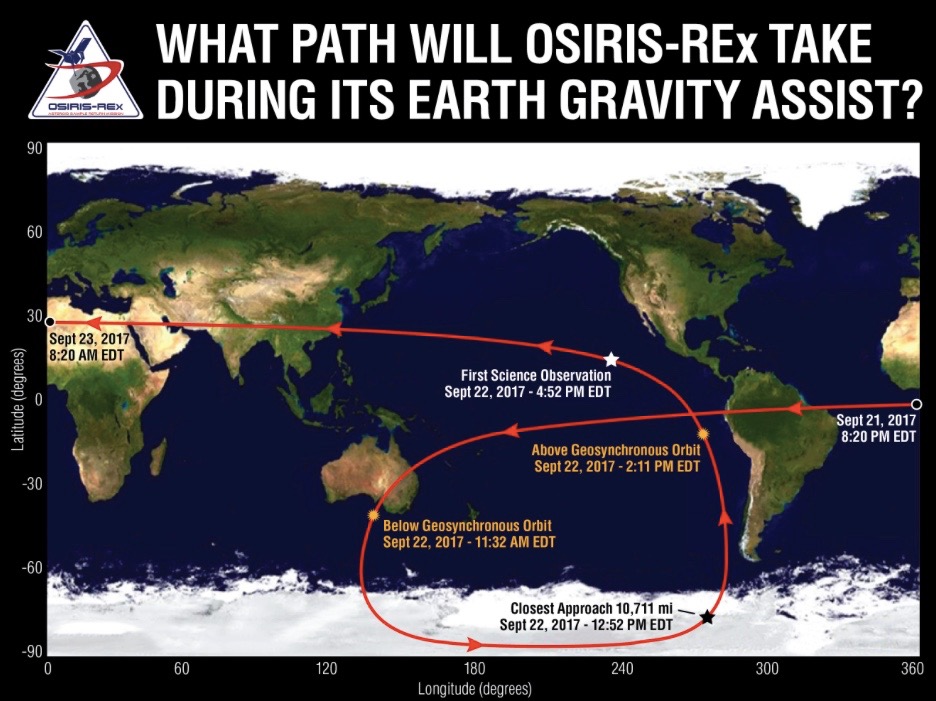Look Up and Wave! OSIRIS-REx Asteroid Probe Flies by Earth Today

Update for 1:58 pm ET: NASA's OSIRIS-Rex spacecraft has successfully buzzed Earth! Read our full story on the gravity assist flyby here.
A NASA spacecraft will zoom past Earth today (Sept. 22) on its way to a distant asteroid, and you can give the probe a proper send-off.
The OSIRIS-REx spacecraft will cruise within just 10,500 miles (17,000 kilometers) of Earth at 12:52 p.m. EDT (1652 GMT) today, using our planet's gravity to slingshot itself toward the 1,640-foot-wide (500 meters) asteroid Bennu.
NASA is encouraging folks around the world to wave at OSIRIS-REx as it goes by today — and to post photos of themselves doing this on Twitter, Instagram and Facebook using the hashtag #HelloOSIRISREx. (You can tag the mission as well; its handle is @OSIRISREx.) [OSIRIS-REx: NASA's Asteroid Sample-Return Mission in Pictures]
If you have a telescope with an aperture of 8 inches (20 centimeters) or larger, you may even be able to get a glimpse of the spacecraft, which will approach Earth at about 19,000 mph (30,600 km/h) and make its closest pass over Antarctica.
"Observers in both hemispheres may be able to see the spacecraft during approach until a few hours before closest flyby," mission team members wrote in a "Spot the Spacecraft" FAQ. "For many observers, the spacecraft will appear in the constellations of Cetus and Pisces."
If you do get a good image, the OSIRIS-REx team would like to see it. The mission is soliciting flyby photos, which can be uploaded here: http://www.asteroidmission.org/upload-spacecraft-imagery/
Get the Space.com Newsletter
Breaking space news, the latest updates on rocket launches, skywatching events and more!
The $800 million OSIRIS-REx mission (whose name is short for "Origins, Spectral Interpretation, Resource Identification, Security, Regolith Explorer") launched on Sept. 8, 2016. If all goes according to plan, the probe will reach Bennu in late 2018.
OSIRIS-REx will study the space rock from orbit for a while, then spiral down to take a sample of dirt and gravel in mid-2020. In 2023, this sample will come to Earth, where scientists in labs around the world will scrutinize it. Such work should shed light on the solar system's early days, as well as the role that primitive, carbon-rich asteroids such as Bennu may have played in delivering life's building blocks to Earth, mission team members have said.

Observations made by OSIRIS-REx while it orbits Bennu could also help researchers learn more about how to nudge potentially dangerous asteroids away from Earth, NASA officials have said. (Bennu is such a space rock; there's a very small chance that it could hit our planet in the late 22nd century.)
Editor's note: If you capture a great photo of OSIRIS-REx through a telescope and would like to share it with Space.com and our news partners for a story or gallery, send images and comments in to: spacephotos@space.com.
Follow Mike Wall on Twitter @michaeldwall and Google+. Follow us @Spacedotcom, Facebook or Google+. Originally published on Space.com.
Join our Space Forums to keep talking space on the latest missions, night sky and more! And if you have a news tip, correction or comment, let us know at: community@space.com.

Michael Wall is a Senior Space Writer with Space.com and joined the team in 2010. He primarily covers exoplanets, spaceflight and military space, but has been known to dabble in the space art beat. His book about the search for alien life, "Out There," was published on Nov. 13, 2018. Before becoming a science writer, Michael worked as a herpetologist and wildlife biologist. He has a Ph.D. in evolutionary biology from the University of Sydney, Australia, a bachelor's degree from the University of Arizona, and a graduate certificate in science writing from the University of California, Santa Cruz. To find out what his latest project is, you can follow Michael on Twitter.









